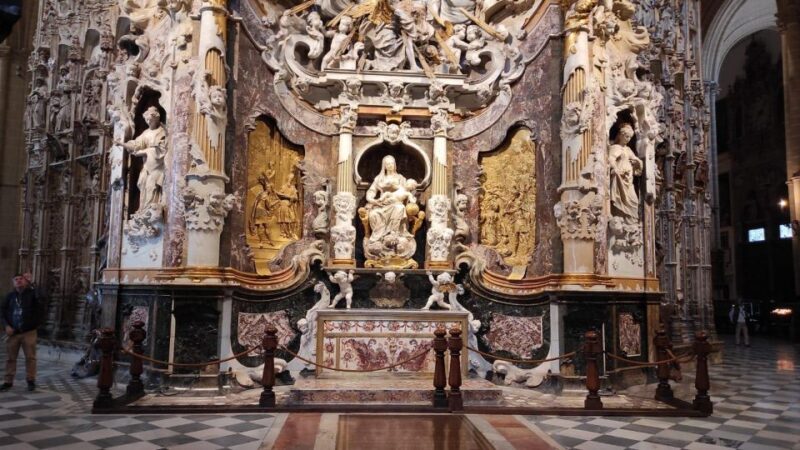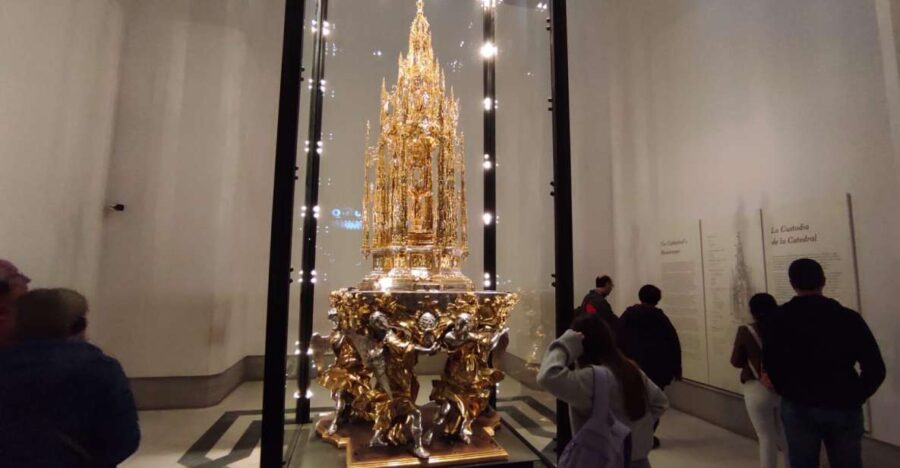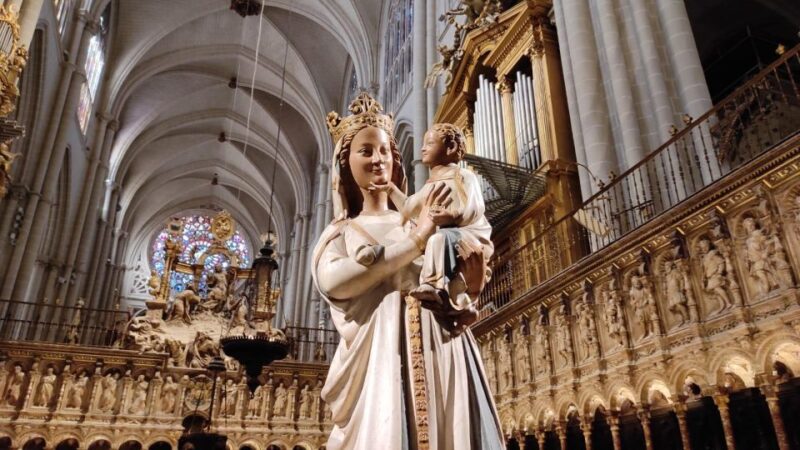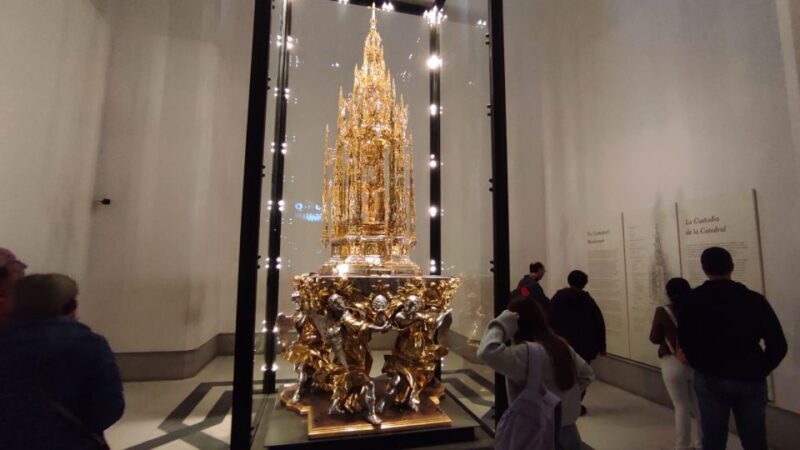Toledo’s rich cultural heritage is reflected in its remarkable collection of religious and architectural wonders. The majestic Toledo Cathedral, Synagogue of Santa María La Blanca, Mosque of Cristo De La Luz, and Monastery of San Juan de los Reyes each offer captivating insights into the city’s diverse past. From the cathedral’s intricate artistry to the Mudéjar-style details of the synagogue, these sites immerse visitors in Toledo’s multicultural influences. Exploring these remarkable structures unveils a captivating journey through the region’s storied history, leaving one eager to uncover more of the city’s enchanting past.
Key Points

-
Toledo’s religious architecture showcases a unique blend of styles, including Mudéjar, Moorish, Romanesque, and Flamboyant Gothic, reflecting the city’s multicultural heritage.
-
The Toledo Cathedral is a majestic architectural marvel renowned for its exceptional preservation and cultural/historical significance.
-
The Synagogue of Santa María La Blanca features intricate Mudéjar-style arched entryways and delicate stucco decorations, preserving centuries of history.
-
The Mosque of Cristo De La Luz combines Moorish architectural elements with Romanesque paintings and Aljamiado inscriptions, highlighting Toledo’s religious diversity.
-
The Monastery of San Juan de los Reyes showcases the Flamboyant Gothic style, featuring intricate Plateresque ornamentation and a collection of medieval gargoyles.
Cathedral: Spectacular Art and Details

The Toledo Cathedral, a majestic architectural marvel, captivates visitors with its spectacular display of artistic masterpieces and intricate details.
This iconic cathedral is filled with an abundance of works of art, making it an essential stop for any traveler.
From the grandeur of its imposing structure to the exquisite craftsmanship of its ornate interiors, the cathedral provides the most important and relevant details that showcase its cultural and historical significance.
Visitors are awed by the cathedral’s exceptional preservation, which allows them to fully enjoy the rich history and artistic legacy of this remarkable landmark.
The Toledo Cathedral’s unparalleled beauty and significance make it a must-see destination for those exploring the city’s remarkable heritage.
You can also read our reviews of more tours and experiences in Toledo.
Synagogue of Santa María La Blanca

Santa María la Blanca, the main synagogue in Toledo during the Middle Ages, stands as a testament to the city’s rich multicultural heritage.
This stunning Mudéjar-style building, constructed in the 12th century, features:
-
Intricate arched entryways adorned with geometric patterns, reflecting the artistry of the Moorish influence.
-
A grand, open interior with slender columns supporting the high, vaulted ceilings, creating a sense of grandeur and light.
-
Delicate stucco decorations and inscriptions along the walls, adding to the synagogue’s elegant and refined atmosphere.
The synagogue has a history that spans centuries, from its use as a place of worship to its transformation into a museum, preserving the cultural legacy of Toledo’s diverse past.
Mosque of Cristo De La Luz

Leaving the serene synagogue behind, one’s gaze is drawn to the striking Mosque of Cristo de la Luz, a captivating architectural gem nestled within Toledo’s historic tapestry.
As you approach the entrance, the remains of a Roman road and the impressive wall captivate the senses.
Step inside and marvel at the mosque’s distinctive Moorish style, with its elegant horseshoe arches and intricate decorative elements. Observe the apse added by the Christians, a fascinating blend of religious influences.
Uncover the intriguing Romanesque paintings and inscriptions in aljamiado, a language that reflects the cultural diversity of the region. The mosque’s current name, Cristo de la Luz, evokes a storied past filled with legends and history.
Wall, Roman Road, and Architectural Style
Upon approaching the Mosque of Cristo de la Luz, one can’t help but be captivated by the remains of a Roman road and the impressive wall that greet visitors at the entrance.
The mosque’s distinctive Moorish architectural style, with its elegant horseshoe arches and intricate decorative elements, creates a mesmerizing visual experience.
The wall, which was likely part of the city’s defensive fortifications, provides a glimpse into Toledo’s rich history.
The Roman road, on the other hand, is a testament to the city’s ancient roots, dating back to the days of the Roman Empire.
These architectural features add depth and context to the overall experience of visiting this iconic religious site.
More Great Thing To Do NearbyRomanesque Paintings and Aljamiado Inscriptions
The Mosque of Cristo de la Luz boasts well-preserved Romanesque paintings and inscriptions in the ancient Aljamiado script, offering a captivating glimpse into the mosque’s storied past.
Aljamiado refers to the practice of writing the Spanish language using Arabic script, a common method among Spanish Muslims during the Middle Ages. These inscriptions adorn the walls of the mosque’s apse, shedding light on the building’s history and the cultural exchange that took place within its walls.
The Romanesque paintings, meanwhile, depict religious imagery and patterns, adding to the mosque’s rich visual tapestry.
Together, these remarkable features make the Mosque of Cristo de la Luz a true testament to Toledo’s multicultural heritage.
Legend of the Current Name
According to legend, the Mosque of Cristo de la Luz acquired its current name due to a miraculous event.
When Christian forces conquered Toledo, they discovered an image of Christ on the cross illuminated by a mysterious light within the mosque’s walls, leading to its renaming as the ‘Mosque of Christ of the Light.’
The legend goes on to describe:
- The image was believed to have been a miraculous manifestation of divine intervention.
- The Christians interpreted this as a sign that the mosque should be consecrated as a Christian church.
- The name ‘Cristo de la Luz’ (Christ of the Light) was chosen to commemorate the miraculous event.
- The mosque was subsequently converted and rededicated as a Catholic place of worship.
Monastery: Artistic Style and Architecture
Situated along the Tajo River, the Monastery of San Juan de los Reyes exemplifies the Flamboyant Gothic architectural style that was popular during the late 15th century.
The church’s altar features intricate Plateresque ornamentation, showcasing the skilled craftsmanship of the era.
Visitors can climb to the upper cloister, where they’ll find a collection of medieval gargoyles adorning the roofline. These unique sculptures not only serve a functional purpose but also add to the building’s striking visual appeal.
Medieval Gargoyles in the Upper Cloister
As visitors climb to the upper cloister, they’re met with a captivating collection of medieval gargoyles adorning the roofline, each one a unique sculptural creation.
These stone monsters weren’t merely decorative – they served a functional purpose as well, channeling rainwater away from the building’s walls.
Some of the gargoyles depict:
- Snarling beasts with gaping mouths.
- Twisted, grimacing faces.
- Mythical creatures with wings and talons.
- Grotesque hybrids of human and animal forms.
The gargoyles provide a fascinating glimpse into the artistic sensibilities and architectural innovations of the medieval period, as well as the imaginative minds of the stonemasons who brought these fantastical creatures to life.
Frequently Asked Questions
What Is the Significance of the Cathedral’s Location in Toledo?
The cathedral’s central location in Toledo reflects its historical importance as the city’s spiritual and architectural centerpiece. Its prominent position underscores the cathedral’s role as a prominent landmark and focal point for the community.
How Old Is the Synagogue of Santa María La Blanca?
The Synagogue of Santa María la Blanca dates back to the 12th century, being one of the main synagogues in Toledo during the Middle Ages. It’s an excellent example of Mudéjar architecture and a significant historical landmark.
What Is the Purpose of the Apse Addition in the Mosque?
The addition of the apse in the Mosque of Cristo de la Luz was done by the Christians to adapt the building for Christian religious use after they conquered Toledo. This architectural change allowed the mosque to function as a church.
Are There Any Guided Tours Available for the Monastery?
The monastery offers guided tours that provide visitors with insights into the artistic style of the building, the church altar, and the medieval gargoyles in the upper cloister. Advance reservations are recommended to secure a spot on these tours.
Can Visitors Climb to the Top of the Cathedral Tower?
Yes, visitors can climb to the top of the cathedral tower. The tower offers panoramic views of the historic city and is a popular activity for travelers exploring the cathedral.
Recap
Toledo’s religious landmarks showcase the city’s captivating multicultural past. The magnificent Cathedral, Synagogue, Mosque, and Monastery each reflect the region’s diverse architectural and artistic influences, from intricate Mudéjar-style details to medieval gargoyles.
Visitors can enjoy Toledo’s rich heritage, exploring the city’s harmonious blend of cultural and religious traditions.
You can check if your dates are available here:More Tour Reviews in Toledo
Not for you? Here's more things to do in Toledo we have recnetly reviewed
- Explore Toledo With a Unique Scavenger Hunt by Wacky Walks
- English Tour “TOLEDO ALL IN ONE”
- English Tour – “TOLEDO 3 CULTURES” ⭐⭐⭐⭐⭐
- Monumental Route – Interior 7 Monuments
- Magical Toledo, the Original Night Route: Mystery, Curiosities and Secrets
- Guided Visit Through Imperial Toledo
- Toledo: Marzipan Convent Route With Tasting and Wine
- Toledo: Convent Route With Marzipan and Wine Tasting
- Toledo and Its 7 Monuments: Tourist Bracelet + Guided Visit
- Puy Du Fou Spain Entry Ticket
- Unholy Toledo Tour: A Self-Drive Gambling and Gangsters Tour
- Subway Toledo: Night Tour 4 Subways Including Thermae
